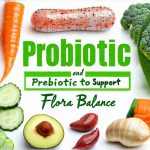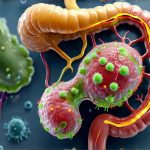The intricate world within our digestive system, often referred to as the gut microbiome, is far more than just a site for nutrient absorption. It’s an ecosystem teeming with trillions of microorganisms – bacteria, fungi, viruses, and archaea – that profoundly influence our overall health, from immunity and mental wellbeing to metabolic function and even disease susceptibility. For years, research focused heavily on what we eat, but increasingly, scientists are realizing that how we eat is equally critical. The physical characteristics of food, the act of chewing, and when we choose to consume meals all play significant roles in shaping the composition and activity of this vital microbial community. Understanding these connections empowers us to make informed dietary choices beyond simply focusing on macronutrient ratios or calorie counts.
The gut microbiome isn’t a static entity; it’s remarkably dynamic, constantly responding to changes in our environment, including the food we ingest. Factors like diet, antibiotic use, stress levels, and even geographical location can dramatically alter its makeup. A diverse and balanced microbiome is generally associated with better health outcomes, while an imbalance – known as dysbiosis – has been linked to a wide range of conditions. This isn’t about eliminating ‘bad’ bacteria; it’s about fostering an environment where beneficial microbes thrive alongside a healthy population of others. Recognizing the influence of texture, chewing and meal timing allows for a more holistic approach to gut health, moving beyond simplistic dietary recommendations towards a nuanced understanding of food’s impact on our internal ecosystem.
Food Texture and Microbial Accessibility
The physical properties of food – its hardness, viscosity, fibrousness – directly affect how easily microbes can access the nutrients within it. Highly processed foods, often smooth in texture and stripped of fiber, provide readily digestible sugars and fats, which are primarily absorbed in the upper digestive tract, leaving less for fermentation by gut bacteria lower down. Conversely, foods rich in complex carbohydrates like resistant starch and non-digestible fibers require more extensive breakdown, creating a favorable environment for microbial fermentation. This process yields short-chain fatty acids (SCFAs) – acetate, propionate, and butyrate – which are crucial energy sources for colon cells, reduce inflammation, and have systemic health benefits.
Consider the difference between drinking orange juice versus eating an orange. Juice delivers readily available sugars with minimal physical challenge to the digestive system. An orange, however, requires chewing and contains fiber that slows down sugar absorption while providing substrate for microbial fermentation. Similarly, a refined white bread offers little textural complexity compared to whole-grain bread, which boasts a more robust structure and higher fiber content. The difference isn’t merely about nutrient density; it’s about how the food interacts with the entire digestive process and ultimately impacts microbial activity. It’s not always about avoiding processed foods entirely, but rather balancing them with enough fibrous, textured whole foods to support a healthy gut environment. How food temperature and meal pacing also play a role here.
Beyond simple carbohydrate complexity, texture also influences transit time – how quickly food moves through the digestive tract. Faster transit times can limit the opportunity for microbes to interact with and ferment food components. Foods with high fiber content tend to slow down digestion, promoting greater microbial access and SCFA production. This is why a diet rich in fruits, vegetables, whole grains, legumes, and nuts – all offering diverse textures and fibers – is often recommended for gut health. Ultimately, the goal isn’t about eliminating certain textures but rather prioritizing those that encourage microbial fermentation and support a balanced ecosystem. Combining warm liquids can further aid this process.
The Role of Chewing
Chewing isn’t merely a preparatory step before swallowing; it’s an integral part of digestion with profound effects on gut flora balance. It initiates the digestive process by physically breaking down food, increasing its surface area for enzymatic action, and mixing it with saliva, which contains enzymes like amylase that begin carbohydrate breakdown. However, chewing also has mechanical impacts beyond enzyme activation. The act of thorough chewing stimulates gastric acid secretion, pancreatic enzyme release, and gut motility, all contributing to efficient digestion and nutrient absorption.
More importantly for our microbiome, prolonged chewing can alter the physical structure of food particles, making them more accessible to microbial enzymes further down the digestive tract. This is particularly crucial for plant-based foods containing cell walls composed of cellulose and other complex carbohydrates. Breaking down these cell walls mechanically through thorough chewing releases intracellular nutrients and exposes them to microbial fermentation. Insufficient chewing can lead to undigested food reaching the colon, where it’s fermented by microbes – but often resulting in gas production and potentially less efficient nutrient extraction. Meal prep ideas can help ensure you have time for mindful chewing.
- Consider these points when improving your chewing habits:
- Eat slowly and mindfully.
- Focus on each bite, taking time to thoroughly break down food.
- Avoid distractions like phones or television while eating.
- Choose foods that require more chewing effort, such as crunchy vegetables and whole grains.
Ultimately, the art of chewing is about maximizing nutrient availability and creating a more favorable environment for microbial fermentation, contributing to a healthier gut microbiome and improved overall digestion. It’s a simple yet powerful tool often overlooked in dietary recommendations. How meal texture impacts this is also important to consider.
Meal Timing and Circadian Rhythm Alignment
Our gut microbiome isn’t isolated from our body clock – the circadian rhythm that governs many physiological processes, including digestion. This internal timekeeper influences microbial composition and activity, with variations occurring throughout the day based on feeding patterns and sleep-wake cycles. Disrupting this natural rhythm through irregular meal timings or late-night eating can negatively impact gut health and contribute to dysbiosis.
Studies suggest that our microbiome exhibits diurnal fluctuations – changes in its composition and function over a 24-hour period, mirroring our activity levels and food intake. For example, certain microbial species are more active during the day when we’re consuming food, while others become dominant during periods of fasting or sleep. Irregular meal timings disrupt this natural cycle, leading to imbalances in microbial populations and potentially reducing SCFA production. Furthermore, eating late at night can interfere with sleep quality, which itself has a reciprocal relationship with gut health. Poor sleep is associated with reduced microbial diversity and increased inflammation. Gut acidity balance can also be impacted by these disruptions.
- To support circadian rhythm alignment:
- Establish regular meal times – even on weekends.
- Avoid large meals close to bedtime.
- Prioritize consistent sleep schedules.
- Consider time-restricted eating, where you confine your eating window to a specific period each day.
The idea isn’t necessarily about restricting when you eat entirely, but rather creating a more predictable and harmonious relationship between your feeding patterns, circadian rhythm, and gut microbiome. By aligning meal timings with our natural body clock, we can support microbial balance and optimize digestive function for improved overall health. This emphasizes that the when of eating is as important as the what. Meal organization techniques can be very helpful here.
Ultimately, fostering a healthy gut microbiome isn’t simply about adding probiotics or focusing on specific foods. It’s about embracing a holistic approach that considers all aspects of our interaction with food – its texture, how we prepare and chew it, and when we choose to consume it. By recognizing these interconnected factors, we can cultivate an internal ecosystem that supports not only digestive health but also overall wellbeing.


















